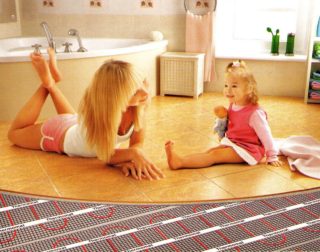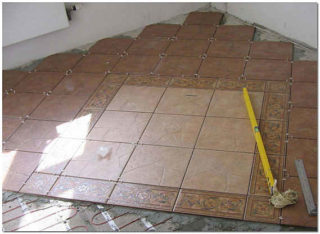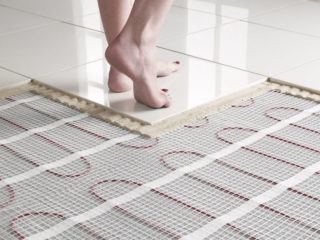When planning the arrangement of underfloor heating in an apartment or a private house, it is important to choose the type of system correctly and not make a mistake with the finish. Otherwise, the proper level of heating efficiency will not be achieved. The tile for a heat-insulated floor is the ideal decision in every respect. To make the best choice, you should familiarize yourself with the assortment and features of products on the market.
Types of laying of underfloor heating
The consumer is presented with a wide selection of systems that can be used for the construction of a warm floor.
The water circuit is equipped in private mansions and with the permission of the management companies on the first floors of apartment buildings. The line is laid with a snake or in a spiral on a heat insulator, and then poured with a cement screed. The advantage of this solution is that it is economically viable; the water stores heat for a long time after turning off the circuit with a thermostat.
Electrical products do not have restrictions on the installation site. Installation can be carried out in residential and utility rooms, balconies and loggias.
Systems are divided into such varieties:
- Cable. They are single-core and two-core resistive and self-regulating (matrix) wires with a thickness of 4-8 mm.
- Matt They look like canvases where a heating wire with a diameter of up to 4 mm is embedded in a plastic mesh.
- Infrared They are made in the form of a film, inside of which are carbon fibers that emit infrared radiation when current is transmitted.
Communications of the warm floor are installed under the screed, in its array or on the outer surface. The latter method is most effective, since it allows you to use all the heat produced by the system.
Decorative Coating Options
When choosing a floor covering, a number of factors must be taken into account that affect the efficiency of heating a room and the people living in it.
Products must comply with the following parameters:
- resistance to high temperatures;
- immunity to constant heating and cooling;
- high thermal conductivity;
- environmental Safety;
- installation technology;
- convenience of service;
- strength;
- durability;
- resistance to abrasion and chemically active substances;
- texture, color and surface design.
Since flooring has been installed for decades, the last thing you need to think about is the cost of materials. It is better to choose an expensive, but high-quality coating, the state of which will not need to worry until the next major overhaul of the building.
The best finishes that are used when installing underfloor heating:
- Ceramic tile. The material has a relatively low cost, high thermal conductivity, heats up quickly, transferring energy with virtually no loss. On sale is an extensive range of products of this type, characterized by various design solutions. The downside is that the outer decorative layer erases over time, and objects falling on the floor leave clearly visible chips on the surface. Tiles of 5-6 hardness class, 4-5 wear resistance class and water absorption of 3-6% should be chosen.
- Porcelain tile. This is a more durable coating, but its cost is higher.The material has a uniform structure throughout the volume, so that mechanical damage is not noticeable on its surface. High thermal conductivity of porcelain stoneware provides efficient heat transfer from the heating element to the room. The downside is that the coating imitates natural stone - this option is poorly suited to the design of living rooms.
- PVC tile. Warm floor tiles without heating preserves performance at any temperature, including negative. Its distinctive feature is a pleasant tactile sensation even when the heater is off. When heated, the material does not emit harmful substances. The average level of thermal conductivity allows laying tiles directly on cable mats or infrared film. Warm floor tiles are easy to install, even a beginner can easily cope with this process.
- Vinyl tile. Warm vinyl floor tiles are an excellent solution for decorating a bedroom, kitchen, or even a room for a child. Vinyl flooring has a multilayer structure with an adhesive backing. It can be glued immediately after removing the protective film without using cement mortar or liquid nails. Ceramic inclusions provide high wear resistance of products, and ultraviolet treatment - color preservation throughout the entire period of operation. Warm tile does not change its properties when heated
The priority when choosing should be given to a material that can provide efficient heating with minimal electricity consumption.
Advantages and disadvantages of tiles for underfloor heating
If we generalize the performance characteristics of the coating for a warm floor, we can distinguish the characteristic pros and cons inherent in all types of materials that are used in residential premises.
Among the advantages include:
- strength;
- water tightness;
- good thermal conductivity;
- variety of textures;
- wide choice of color schemes;
- simplicity of laying;
- durability;
- dielectric qualities;
- ease of cleaning from contamination.
The material has its drawbacks. The main thing is the presence of seams that are visually visible and feel to the touch. Tiles and porcelain tiles when the heater is turned off become cold and unpleasant to walk. Tiles crack when solid objects fall on it. If there is no stock, replacement can cause serious difficulties.
Material Features
Tiles and porcelain tiles have almost the same technical characteristics. The difference is only in composition, hardness and porosity. At the same time, both materials are excellent conductors in direct-acting structures. The floor, covered with hard tiles, is able to qualitatively heat the room even in stand-alone mode without wall radiators. However, such a coating requires a high-quality and sensitive thermostat. Good conductivity can cause overheating. Comfortable is the temperature of the floor in the range of 23-28 degrees.
Tiles made of vinyl and PVC have a lower thermal conductivity. On the one hand, this is good, since a critical temperature increase is excluded. On the other hand, more energy is required in order to provide comfortable indoor conditions. Synthetic coating responds better to shock, cushioning under heavy loads.
Mounting methods for selected items
Installation methods vary significantly depending on the composition and shape of the elements of the floor heating. One thing is common in all cases - high-quality leveling of the base and its primer to improve adhesion.
Tiles and porcelain tiles are laid on glue, the basis of which is cement. It is possible to use mortars packaged in tubes; it is faster, easier, but more expensive.Laying is carried out in even rows, with offset or diagonally. Equalization is achieved using plastic crosses. After the solution solidifies, they are removed, and the seams are overwritten.
The polymer fragments are fixed on the plate on an adhesive back-to-back basis or are fastened directly to the screed by the floating method. In this case, gluing is performed only on the chamfers at the edges of the products.







